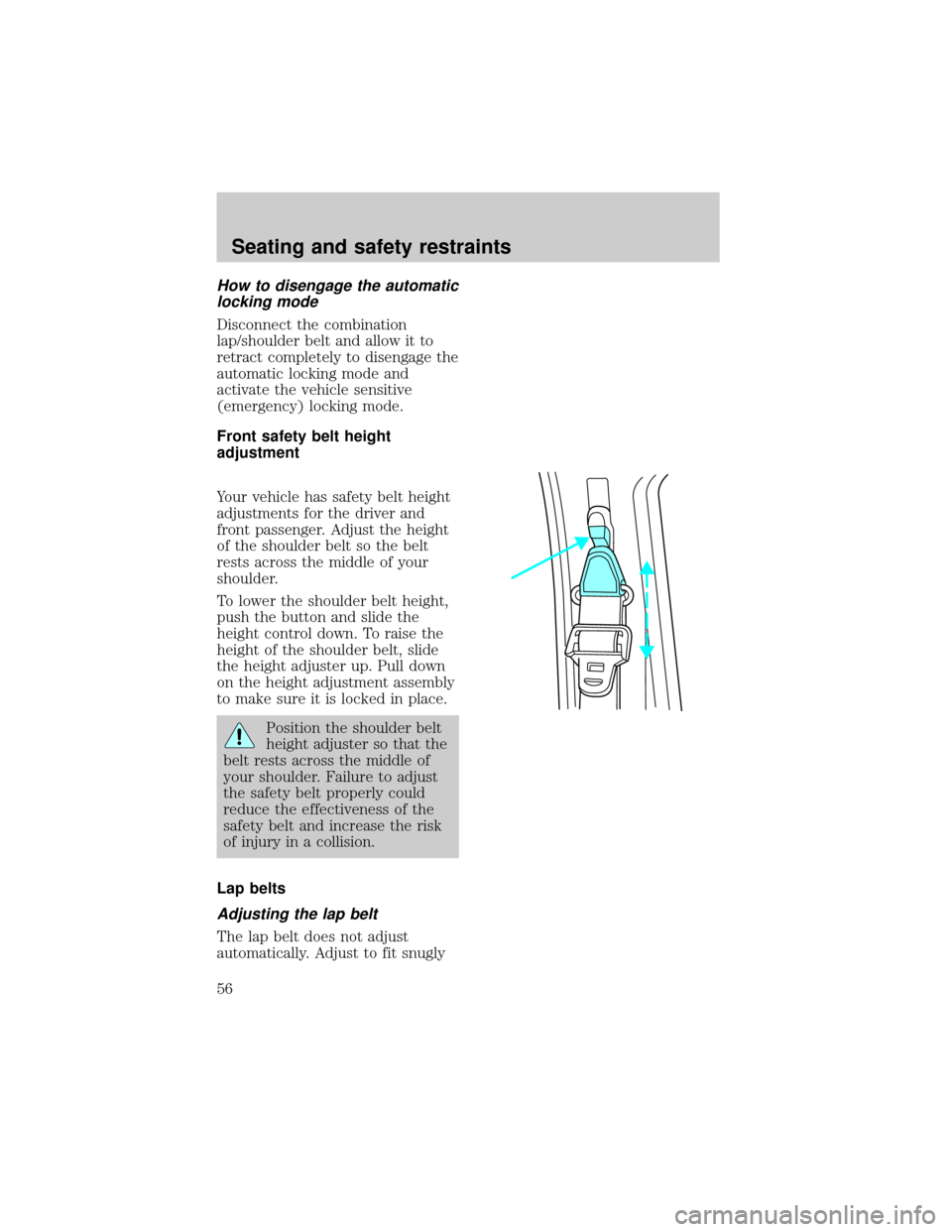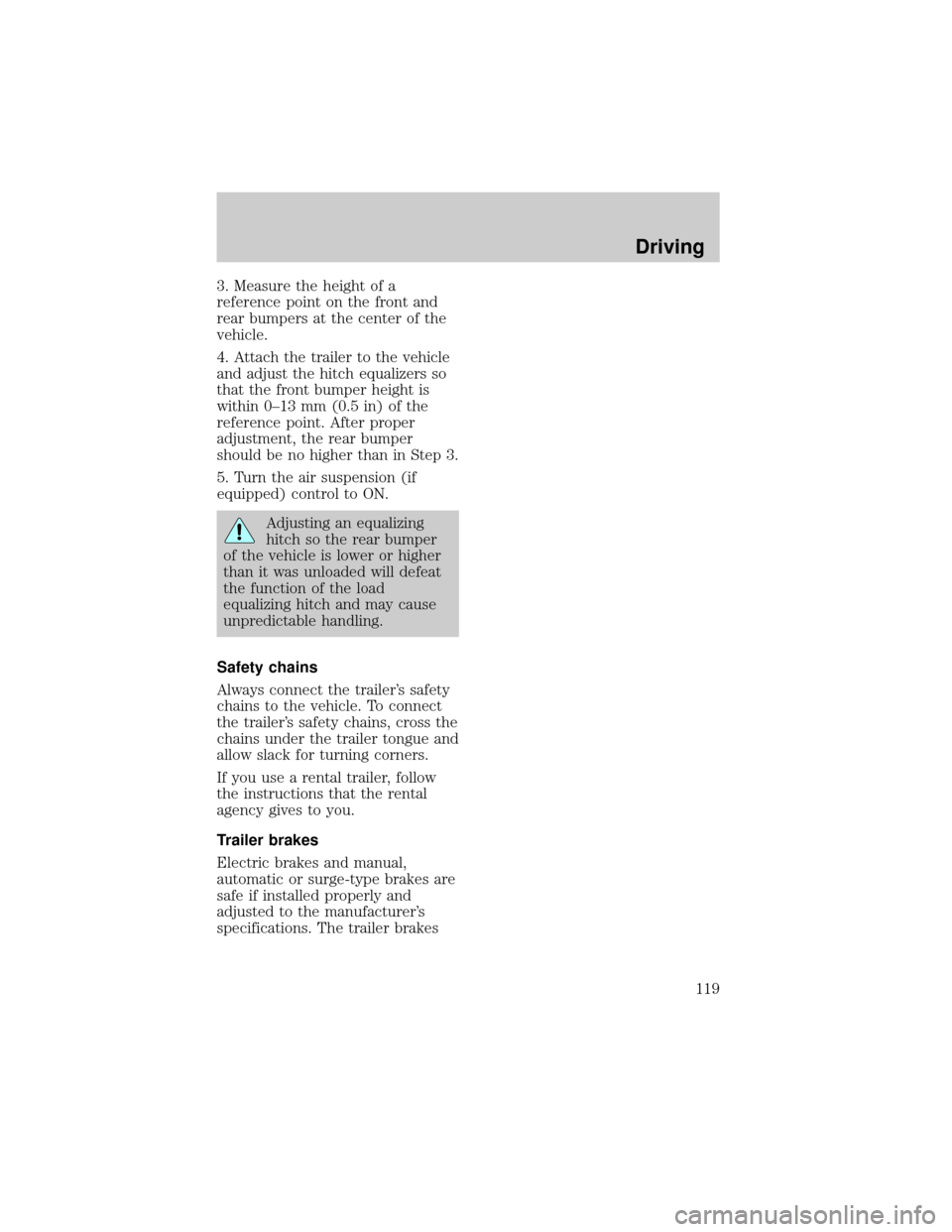Page 56 of 219

How to disengage the automatic
locking mode
Disconnect the combination
lap/shoulder belt and allow it to
retract completely to disengage the
automatic locking mode and
activate the vehicle sensitive
(emergency) locking mode.
Front safety belt height
adjustment
Your vehicle has safety belt height
adjustments for the driver and
front passenger. Adjust the height
of the shoulder belt so the belt
rests across the middle of your
shoulder.
To lower the shoulder belt height,
push the button and slide the
height control down. To raise the
height of the shoulder belt, slide
the height adjuster up. Pull down
on the height adjustment assembly
to make sure it is locked in place.
Position the shoulder belt
height adjuster so that the
belt rests across the middle of
your shoulder. Failure to adjust
the safety belt properly could
reduce the effectiveness of the
safety belt and increase the risk
of injury in a collision.
Lap belts
Adjusting the lap belt
The lap belt does not adjust
automatically. Adjust to fit snugly
Seating and safety restraints
56
Page 59 of 219
assemblies, including retractors,
buckles, front seat belt buckle
assemblies (slide bar)(if
equipped), shoulder belt height
adjusters (if equipped), child
safety seat tether bracket
assemblies (if equipped), and
attaching hardware, should be
inspected after a collision. Ford
recommends that all safety belt
assemblies used in vehicles
involved in a collision be replaced.
However, if the collision was minor
and a qualified technician finds
that the belts do not show damage
and continue to operate properly,
they do not need to be replaced.
Safety belt assemblies not in use
during a collision should also be
inspected and replaced if either
damage or improper operation is
noted.
Failure to replace the
safety belt assembly under
the above conditions could result
in severe personal injuries in the
event of a collision.
Refer toCleaning and
maintaining the safety beltsin
theMaintenance and care
section.
Seating and safety restraints
59
Page 87 of 219
normal driving and should not be
noticeable to the driver.
To avoid injury, never run
the engine with one wheel
off the ground, such as when
changing a tire.
AIR SUSPENSION SYSTEM (IF
EQUIPPED)
The air suspension system is
designed to improve ride, handling
and general vehicle performance
for static, on and off-road driving
conditions.
²The load leveling feature of the
air suspension automatically
keeps the vehicle at a constant
level if a load is added or
removed from the vehicle.
²The height adjustment feature
automatically controls the
vehicle height over a range of
approximately 5 cm (2 inches)
based on vehicle speed, ignition
position and selection of two or
four-wheel drive modes.
Driving
87
Page 119 of 219

3. Measure the height of a
reference point on the front and
rear bumpers at the center of the
vehicle.
4. Attach the trailer to the vehicle
and adjust the hitch equalizers so
that the front bumper height is
within 0±13 mm (0.5 in) of the
reference point. After proper
adjustment, the rear bumper
should be no higher than in Step 3.
5. Turn the air suspension (if
equipped) control to ON.
Adjusting an equalizing
hitch so the rear bumper
of the vehicle is lower or higher
than it was unloaded will defeat
the function of the load
equalizing hitch and may cause
unpredictable handling.
Safety chains
Always connect the trailer's safety
chains to the vehicle. To connect
the trailer's safety chains, cross the
chains under the trailer tongue and
allow slack for turning corners.
If you use a rental trailer, follow
the instructions that the rental
agency gives to you.
Trailer brakes
Electric brakes and manual,
automatic or surge-type brakes are
safe if installed properly and
adjusted to the manufacturer's
specifications. The trailer brakes
Driving
119
Page 126 of 219

must not exceed the front
accessory reserve capacity.
²The total weight of the
snowplow and aftermarket
equipment must not exceed the
Total Accessory Reserve
Capacity.
²The weight of the installed
snowplow and aftermarket
equipment must not load the
vehicle beyond the GAWR
(front/rear) and GVWR listed on
the Safety Compliance
Certification Label.
²The total weight of the
snowplow and aftermarket
equipment must be considered
part of the payload and must
not exceed the Gross Combined
Weight Rating (GCWR) for
towing.
²Federal and most local
regulations require additional
exterior lamps for
snowplow-equipped vehicles.
Consult your dealer for
additional information.
²After installing a snowplow to
the vehicle, ensure the vehicle's
front toe alignment and front
ride height are within
specification (reset if required).
These specifications are located
in the vehicle's Workshop
Manual. Adherence to the toe,
tire pressures and ride height
specification is important for
proper tire wear, ride, handling
and headlight aim. Also,
Driving
126
Page 127 of 219
maintain the engine oil and
transmission fluid change
intervals.
Do not exceed the GVWR
or the GAWR specified on
the Safety Compliance
Certification Label.
Removing snowplow
Read the following instructions
before removing a snowplow:
²After removing a snowplow from
the vehicle, ensure the vehicle's
front toe alignment and front
ride height are within
specification (reset if required).
These specifications are located
in the vehicle's Workshop
Manual. Adherence to the toe
and ride height specification is
important for proper tire wear,
ride, handling and headlight aim.
Snowplowing with your air bag
equipped vehicle
Your vehicle is equipped with
driver and passenger air bags. The
air bags are designed to deploy in
a collision with a solid barrier at a
range of 13 to 23 km/h (8 to 14
mph) or a parked car at a range of
25 to 45 km/h (16 to 28 mph).
Careless or high speed driving
while plowing snow which results
in vehicle decelerations equivalent
Driving
127
Page 211 of 219

DimensionBody Style
Regular
Cab 4x2Regular Cab
4x4Super Cab
4x2Super Cab
4x4
(3) Overall
height1 846 mm
(72.7 in)
(SWB) 1838
mm (72.4
in) (LWB)1 917 mm
(75.5 in)
(SWB)1 907
mm (75.1 in)
(LWB)1 846 mm
(72.7 in)
(SWB)1 838
mm (72.4 in)
(LWB)1 917 mm
(75.5 in)
(SWB)1
907mm (75.1
in) (LWB)
(4)Wheel
base3 022 mm
(119.9 in)
(SWB)3 505
mm (138.5
in) (LWB)3 048 mm
(120.2 in)
(SWB) 3 505
mm (138.8
in) (LWB)3 505 mm
(138.5 in)
(SWB) 3 987
mm (157.1
in) (LWB)3 505 mm
(138.8 in)
(SWB) 3 987
mm (157.4
in) (LWB)
(5)Track
front/rear1 661 mm
(65.4 in)/1
661 mm
(65.4 in)1 661 mm
(65.4 in)/1
661 mm (65.4
in)1 661 mm
(65.4 in)/1
661 mm (65.4
in)1 661 mm
(65.4 in)/1
661 mm
(65.4 in)
Flareside
DimensionBody Style
Regular
Cab 4x2Regular
Cab 4x4Super Cab
4x2Super Cab
4x4
(1)Overall
length5 229 mm
(205.9 in)5 267 mm
(207.4 in)5 702 mm
(224.5 in)5 740 mm
(226.0 in)
(2) Overall
width2 009 mm
(79.1 in)2 026 mm
(79.8 in)2 009 mm
(79.1 in)2 026 mm
(79.8 in)
(3) Overall
height1 846 mm
(72.7 in)1 917 mm
(75.5 in)1 846 mm
(72.7 in)1 917 mm
(75.5 in)
(4)Wheel
base3 045 mm
(119.9 in)3 053 mm
(120.2 in)3 517 mm
(138.5 in)3 525 mm
(138.8 in)
(5) Track
front/rear1 661 mm
(65.4 in)1 661 mm
(65.4 in)1 661 mm
(65.4 in)1 661 mm
(65.4 in)
Capacities and specifications
211